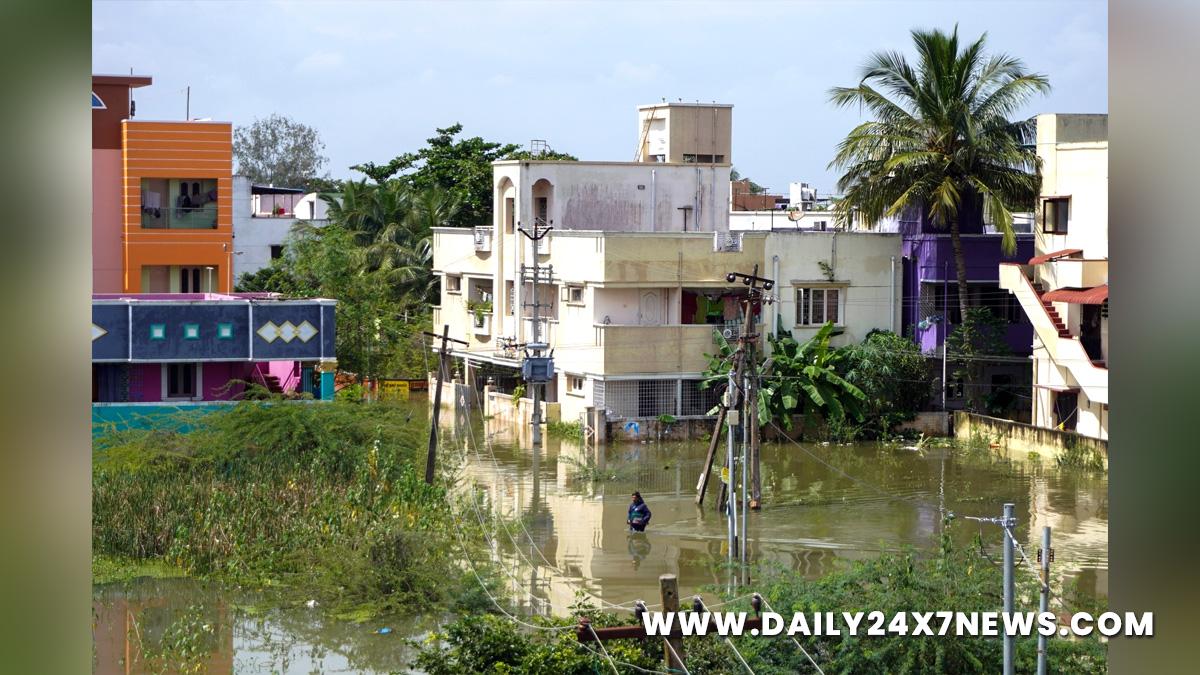Floods, water-logging and water scarcity become cyclic woes of Chennai residents

Chennai : Chennai and its adjoining areas were recently inundated in water after heavy rain in the space of a fortnight and the water, mixed with sewage and petrol, had entered several homes. This is a phenomenon Chennai has been facing year after year while in summer the city is totally devoid of water. A common scene in the city during summer is colourful pots lined up before a water tap with anxious people waiting for their turn to fill them.Sudharani, a software professional working with a MNC, told IANS: “I live in TNagar and work at OMR. It was a harrowing experience last week with water entering our homes and surrounding areas with a dirty smell and mixed with petrol and sewage. For the past several years, we are experiencing this and whoever comes to power is turning a blind eye to this problem. Poor planning and the contractor-bureaucrat-politician nexus is creating this problem and and unless this is dealt with strongly, Chennai as a city is lost.”She said that during summer the same city is languishing for water and people have to stand in long queues to get a bucket of water, either from the corporation or private suppliers.The 2015 floods were the worst for Chennaites with 400 people losing their lives. Property was destroyed, vehicles were submerged in water, and boats were used as the mode of transport. However the rulers apparently did not learn any lesson from that. With changing weather patterns and environmental issues, depressions are a regular feature in the Bay of Bengal and the Arabian Sea leading to heavy downpours and westerly winds.Chennai, according to the available data, has 2780 km of roads but the water drains of the city are limited to 1,894 km. The Planning Commission has recommended the construction of water drains to a length of 5000 km to properly flush out water but nothing has happened.
While the 1,894 km water drains would have taken the brunt of the water, these drains are filled with plastic and garbage. There seems to be no plan to clear these drains of the plastic and garbage which results in the water not getting out properly.There are two freshwater rivers, Cooum and Adyar, and both are stagnant with plastic and garbage. They are not cleaned and all the wastewater flows into them. Hence they turns filthy with stagnating water — another reason for the water not going out properly.While the Madras High Court had given a decision to convert the Pallikarani marshland into a Ramsar site, several parts of the marshy land which would have acted as a sponge to absorb water, are turning into a concrete jungle with residential colonies, buildings housing institutions, and even garbage dumping yards.Chennai had 60 large water bodies a century ago but now they have come down to just four — Redhills, Cholavaram, Poondi and Chembarambakkam. Almost all the water bodies have been converted into garbage yards and filled. These were sold to contractors with the politician-bureaucrat-contractor nexus becomes fatter at the expense of the environment and the people of Chennai.The temple tanks which used to help maintain groundwater levels have also been filled up and even the Murudeshwar temple at Tiruvanmyur that had five tanks has only one left. The rest of the tanks have been filled with soil and garbage and have made way for new gleaming concrete buildings.Groundwater levels have come down leading to a drought-like situation in summer and water-logging and inundation during the rains. Chennaites are suffering in both seasons, and lack of proper planning is quite obviously the reason for this.
Sudheeshkumar, who retired as a senior engineer with an automobile major and lives at Pammal in Chennai, told IANS: “Wrong planning, greed of our bureaucrats and politicians have made our good old Chennai into a city with people having nightmares during the rains and extreme suffering during summer for lack of water. This is unique to Chennai and the reason is poor and improper planning and preparations. Floods have become an annual phenomenon and planners have to prepare for this in advance but nothing happens and the public is left to the mercy of the rain gods.”Now people are looking to Chief Minister M.K. Stalin for change. The first priority for almost everyone is to clear the two freshwater rivers of the city, Cooum and Adyar. Several lakes have been lost. The temple tanks have to be restored and encroachments have to be removed. The Madras High Court has always been willing to listen to the woes of the people and has delivered several landmark judgments to restore the water flow and also to prevent environmental degradation.The HR&CE department has taken welcome measures to remove encroachments. If it also takes steps to retrieve the lost temple tanks and ponds, the city will be much better off for water and to face the downpours.C. Rajeev, Director, Centre for Policy and Development Studies based out of Anna Nagar in Chennai, told IANS: “Unless the government takes a strong stand against encroachers and cracks down on the contractor-bureaucrat-politician nexus, things will not improve in Chennai. It has been a cyclic phenomenon and people are suffering. During the rains it is water-logging, inundation, water mixed with sewage entering homes, and in summer we can see long queues of women standing to get a pot of water. This is only due to the failure of the administration and the governments that have ruled the state have to answer to the public.”

Comments are closed.